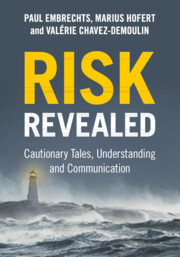Book contents
- Frontmatter
- Dedication
- Contents
- Preface
- Introduction
- 1 The 1953 Great Flood
- 2 The Space Shuttle Challenger Disaster
- 3 The 2007–2008 Financial Crisis
- 4 Earthquakes and Tsunamis
- 5 The L’Aquila Trial and the Public Communication of Risk
- 6 The Coronavirus Pandemic
- 7 Mathematical Wonderland
- 8 Stochastic Modeling
- 9 The Modeling of Extreme Events
- 10 On Climate Change and Related Risk
- 11 Further Examples from the World of Extremes
- 12 Networks
- 13 The Black Tulip and February 3, 1637
- A Note About the References
- References
- Index
1 - The 1953 Great Flood
Published online by Cambridge University Press: 05 April 2024
- Frontmatter
- Dedication
- Contents
- Preface
- Introduction
- 1 The 1953 Great Flood
- 2 The Space Shuttle Challenger Disaster
- 3 The 2007–2008 Financial Crisis
- 4 Earthquakes and Tsunamis
- 5 The L’Aquila Trial and the Public Communication of Risk
- 6 The Coronavirus Pandemic
- 7 Mathematical Wonderland
- 8 Stochastic Modeling
- 9 The Modeling of Extreme Events
- 10 On Climate Change and Related Risk
- 11 Further Examples from the World of Extremes
- 12 Networks
- 13 The Black Tulip and February 3, 1637
- A Note About the References
- References
- Index
Summary
During the night of January 31 to February 1, 1953, the southwest coast of the Netherlands experienced a ferocious storm, killing over 1800 people, causing untold suffering and a major economic loss. As a consequence, the Dutch government initiated the Delta Project, which, through a combination of engineering works, should make the country safe for years to come. As part of this project, risk measures were introduced, like the so-called Dutch standard of a 1 in 10 000 years safety measure. Their statistical estimation was worked out and embedded in major engineering projects. These resulted in the construction of numerous new dikes along the coast. Through this example, we highlight several aspects of hazard protection. First, mathematics has an important role to play. Second, interdisciplinarity is key. Third, with such major and costly projects, spanning several generations, a clear communication to politicians as well as the public is both demanding as well as necessary.
- Type
- Chapter
- Information
- Risk RevealedCautionary Tales, Understanding and Communication, pp. 1 - 12Publisher: Cambridge University PressPrint publication year: 2024



